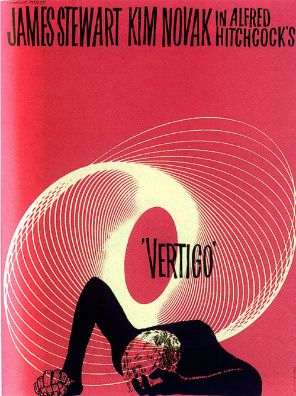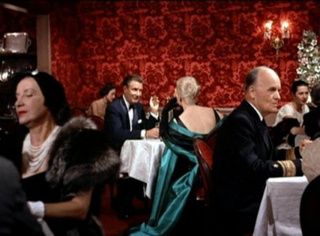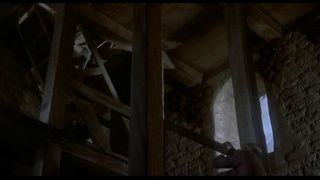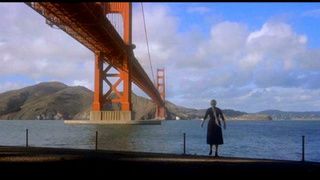
Vertigo
Director: Had to be Hitchcock
Starring: James Stewart, Kim Novak, Barbara Bel Geddes, The City of San Francisco
1958
It is not understating it to say that Vertigo is the ultimate Hitchcock movie, but you have to ask yourself, “Why?” Hitchcock is known as the master of suspense, but the mystery in Vertigo is solved and all is revealed with a third of the film left to go. In terms of mystery, Vertigo doesn’t fit with other Hitch standards like Rear Window or North by Northwest. No, this is the ultimate Hitchcock film for an entirely different reason. Of all his work, Vertigo is clearly the most personal, the most intimate, the most soul-baring piece of film he ever presented. And it is this fact that also makes Vertigo his most disturbing film.
Stewart plays John ‘Scottie’ Ferguson, a former police detective forced to retire due to psychological and physical issues surrounding an incident that left another cop dead and him hanging from the side of a building. An old friend from college convinces Scottie to do some private detective work for him, following his wife around. Apparently, Madeleine the wifey (Novak) is slightly off her rocker and appears to be possessed by the spirit of a melodramatic nineteenth century ghost, intent on getting wifey to kill herself. Scottie is immediately smitten with Madeleine, and things go from complicated to downright twisted.
Long before M. Night Shyamalan made a name for himself by playing with symbolic uses of color in a film, Hitchcock did it in Vertigo. Red and green take center stage in this gorgeous Technicolor film, contrasted continually and explicitly with dull grays and browns. Take the moment when Scotty first lays eyes on Madeleine; he is in a restaurant with the most brilliantly red velvet walls, symbolizing his impending aggression and passion. Scotty is wearing a nondescript navy suit, all other diners are wearing neutrals. We see Madeleine across the restaurant, where she is bedecked in the most glamorous, glittering emerald green evening gown. Scotty does a tiny double take then stares, open-mouthed. Instantly, envy, greed, jealousy and lust are born, all feelings that are engendered by the color green. Red and green appear again and again throughout the film; in wardrobe choices, in sets, in lighting choices. Later in the film, Madeleine’s doppelganger (also played by Novak) Judy’s apartment is bathed in a sickly green light coming from the neon sign outside, giving the entire room an eerie glow. Hitchcock is constantly reminding us of the most unpleasant feelings these colors symbolize.

The color work, as brilliant as it is, is a mere underpinning to the phenomenally ugly psychological maelstrom that is the two main characters, and herein lies the window to Hitchcock’s soul. Hitchcock was rather obsessed with obsession, and Vertigo is the ultimate film about obsession. Scotty is instantly obsessed with Madeleine, driving him to do things he would never ordinarily do. Later in the film, Scotty is obsessed with turning Judy into Madeleine through a series of increasingly uncomfortable “dress up” scenes. Judy, for her part, has become obsessed with making Scotty love her, so she reluctantly goes along with the aggressively suggested changes. He is obsessed with the woman he wants her to be, and she is obsessed with making herself into the woman he wants her to be. Neither of them are seeing the other for their true self; they are too far down the dark, twisted path together, co-dependent to the last. There is no violence, no blood, no gore in Vertigo, but Hitchcock manages to grow these two deeply emotionally damaged characters up to a point where watching them interact with one another becomes an immensely uncomfortable cinematic experience. In the final climactic scene, Scotty and Judy argue. It is desperate, it is angry, and it is physical. Herein, though, lies the humanity of Hitchcock; although these are two depraved characters, we also feel some bizarre sense of sympathy towards them. How horrible that they have been driven to this point; how sad that they find themselves up against this wretched, wretched wall.

Kim Novak as Madeleine is the ultimate Hitchcock ice princess. Cool, detached, unemotional, yet compelling, she represents everything that Hitchcock sees in a blonde. Interesting, too, that hers is a pale, platinum blonde; she is not a warm blonde, a golden, sun kissed blonde, but rather icy and severe. Contrasted with Novak’s ice princess is Geddes’ blonde Midge. Here is the golden blonde, the nice blonde, the warm blonde, the blonde who is secretly in love with Scotty, but who is not nearly exotic enough nor unavailable enough to tempt him. She is the blonde next door, and she will not do.
San Francisco takes front and center as the backdrop to the film. In few films have I been more acutely aware of the setting. The constant hills – of driving up and down, through twists and turns – is somehow unsettling. Scotty’s apartment is located on a hillside, and it reminds you that his life is heading downhill. Of course, all the interiors were shot on soundstages, but Hitchcock made phenomenal use of location shooting, choosing spots with otherworldly appeal, from a Spanish mission to the redwood forests. Easily one of the best location movies ever shot.

For as amazing a film as Vertigo is, I find it to be a difficult film to love. Easy to appreciate, yes; but love? For me, no. Which is not to say that I don’t love Hitchcock; on the contrary, several of his films rank way up on my list of favorites. But I find Vertigo deeply unsettling – as, no doubt, he intended – to the point where I cannot love it. I like it a great deal, but I fear my affection for it will never blossom beyond that. Jimmy Stewart is too good at being so bad, and I prefer my Jimmy Stewart more benign. This is merely a matter of personal taste, however, and in no way prevents me realizing Vertigo as the masterpiece that it is, the most deeply personal work of one of the most famed directors of all time.
Arbitrary rating: 8/10 for personal reasons
Of Hitchcock's five truly great films (Vertigo, Rear Window, North by Northwest, The Birds and Psycho), this one is my least favorite. It's good, even great, but it's not those other four by a long shot. It feels cruel in many ways, and while Hitchcock loved cruelty, this one seems needlessly so.
ReplyDeleteHowever, here's the best thing to come after the film: http://www.youtube.com/watch?v=9UrdY6AwSUQ
Nice video! That was a hoot.
DeleteI definitely agree about the cruelty here. It's a fascinating film, but as I said, I can't love it. Those other films are certainly better.
(Although I do think I owe Psycho a second viewing - it was a victim of being impossibly over-hyped and ending-spoiled. I wound up feeling a little unimpressed.)
I actually don't consider Vertigo to be that great a film. Here's why. I have a pretty good memory of the movies I've seen. Even if I don't remember them from beginning to end I still remember scenes or lines. In a short two year time span I saw Vertigo twice and was about halfway through it the second time before realizing that I had already seen it only two years earlier. (It was the tree ring scene that triggered this, if you are curious).
ReplyDeleteThe film made so little an impression on me that I didn't even remember anything from the first 50 minutes or so only two years after seeing it. Heck, I can still describe scenes from Gus, a Disney movie about a donkey that kicked field goals that I saw at a drive in as a kid in the mid 1970s. (He's good up to 100 yards, but after that his kicks might not be reliable.)
Y'know, that's a great way to judge a film; the depth of impression it leaves on you. I wholeheartedly agree that if a film fails to impact you, it's not ranked among the best films.
DeletePart of the reason for this blog is so I can remember more films with more detail. My film memory is not as awesome as yours!
I've been asked how I can remember things and my standard answer is, "I remember things that amuse me...and I'm easily amused."
DeleteThe honest answer is that I don't know how memory works. Things I don't know are there just get triggered out of my memory when I encounter something related to them. I recently had a conversation with my nephew where I taught him a mnemonic I learned about 30 years ago to help remember the divisions of biological life - King Philip Came Over From Germany Swimming (kingdom, phylum, class, order, family, genus, species). I probably hadn't thought of it for at least 25 years, but when he mentioned trying to learn those, there it was in my head. (And yes, I did kill at Trivial Pursuit in the 80s.)
On the other hand, if I'm introduced to some random stranger at a gathering, ten seconds later I wouldn't be able to tell you their name unless I made a special effort to remember it. I'm sure a psychologist would have a field day with that.